A) an extra 25 cents and sellers will receive 75 cents less.
B) an extra 75 cents and sellers will receive 25 cents less.
C) an extra 50 cents and sellers will receive 50 cents less.
D) nothing extra since this is the special case where demand is unit elastic.
F) A) and C)
Correct Answer

verified
Correct Answer
verified
Essay
A market is described by the equations Qd = 100 - P, and Qs = P. A tax of $10 is placed on the buyer of the product such that the new demand equation becomes Qd = 100 - (P + T), where T is the tax is dollars. Does the buyer pay the whole $10 of the tax burden? How much does the buyer pay? How much does the seller pay? Why do they split the burden in this way?
Correct Answer

verified
Correct Answer
verified
Multiple Choice
A subsidy is:
A) similar to a reverse tax.
B) calculated as the price received by sellers minus the price paid by buyers.
C) paid for by taxpayers.
D) All of the answer choices are correct.
F) C) and D)
Correct Answer

verified
Correct Answer
verified
Multiple Choice
A wage subsidy will:
A) reduce the wages received by workers.
B) reduce the number of workers employed.
C) increase the number of workers employed.
D) increase the unemployment rate, especially among low-skilled workers.
F) A) and D)
Correct Answer

verified
Correct Answer
verified
Multiple Choice
Which one of the following statements about subsidies is NOT correct?
A) Subsidies cause deadweight losses.
B) Who actually receives the subsidy does not depend on who gets the check from the government.
C) Subsidies always increase the gains from trade for producers.
D) Who benefits from the subsidy depends on the relative elasticities of demand and supply.
F) A) and C)
Correct Answer

verified
Correct Answer
verified
True/False
Subsidies lead to existence of non-beneficial trades.
B) False
Correct Answer

verified
Correct Answer
verified
Essay
Correct Answer

verified
Correct Answer
verified
Multiple Choice
(Figure: Tax on Consumers of Gadgets) According to the figure, what is the amount of the tax that has been imposed on gadgets? Figure: Tax on Consumers of Gadgets 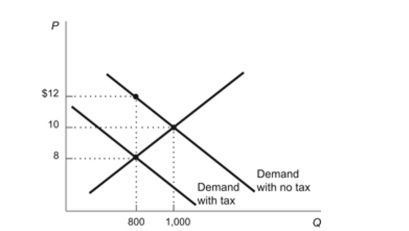
A) $ 4
B) $ 2
C) $ 8
D) $ 12
F) B) and C)
Correct Answer

verified
Correct Answer
verified
Multiple Choice
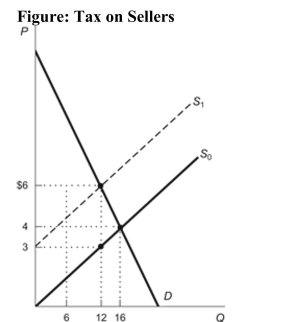 Reference: Ref 6-1 (Figure: Tax on Sellers) If a $3 tax per unit purchased was placed on buyers instead of sellers, buyers would pay ________ and sellers would receive ________.
Reference: Ref 6-1 (Figure: Tax on Sellers) If a $3 tax per unit purchased was placed on buyers instead of sellers, buyers would pay ________ and sellers would receive ________.
A) $3; $6
B) $6; $3
C) $4; $6
D) $4; $3
F) A) and D)
Correct Answer

verified
Correct Answer
verified
True/False
When demand is more elastic than supply, buyers bear more of the tax burden.
B) False
Correct Answer

verified
Correct Answer
verified
Multiple Choice
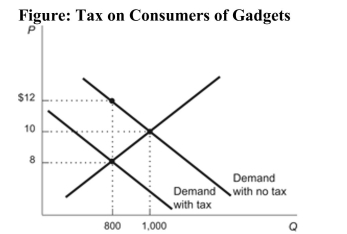 Reference: Ref 6-8 (Figure: Tax on Consumers of Gadgets) Refer to the figure. What is the amount of the deadweight loss caused by the imposition of the tax on gadgets?
Reference: Ref 6-8 (Figure: Tax on Consumers of Gadgets) Refer to the figure. What is the amount of the deadweight loss caused by the imposition of the tax on gadgets?
A) $800
B) $3,200
C) $400
D) $200
F) None of the above
Correct Answer

verified
Correct Answer
verified
Multiple Choice
Which of the following statements is TRUE? I. A $0.50 tax on each fishing lure sold raises the price per lure by $0.50. II. A tax on sellers is equivalent to a tax on buyers. III. A tax on buyers is analyzed by shifting the demand curve up by the amount of the tax.
A) I and II only
B) II and III only
C) II only
D) I, II, and III
F) A) and B)
Correct Answer

verified
Correct Answer
verified
Multiple Choice
Which of the following is the correct answer to the question: Why do smokers pay almost all the taxes assessed on cigarettes? I. Because they are addictive, the demand for cigarettes is relatively elastic when compared to the supply curve of cigarettes. II. Because they are addictive, the demand for cigarettes is relatively inelastic when compared to the supply of cigarettes. III. Cigarette manufacturers can very easily escape a state tax by selling in a different state.
A) I only
B) II only
C) I and III only
D) II and III only
F) B) and D)
Correct Answer

verified
Correct Answer
verified
Multiple Choice
Not only do both wage subsidies and minimum wages increase wages, but:
A) they also increase employment.
B) they also reduce employment.
C) subsidies increase employment, whereas minimum wages reduce it.
D) subsidies reduce employment, whereas minimum wages increase it.
F) B) and C)
Correct Answer

verified
Correct Answer
verified
Multiple Choice
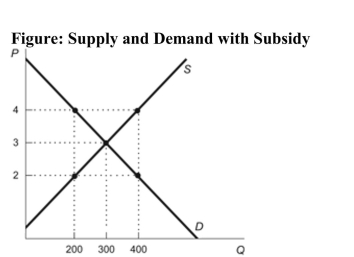 Reference: Ref 6-9 (Figure: Supply and Demand with Subsidy) Refer to the figure. With a $2-per-unit subsidy, the price received by sellers is ________ and the price paid by consumers is ________.
Reference: Ref 6-9 (Figure: Supply and Demand with Subsidy) Refer to the figure. With a $2-per-unit subsidy, the price received by sellers is ________ and the price paid by consumers is ________.
A) $3; $2
B) $2; $4
C) $4; $2
D) $3; $4
F) B) and C)
Correct Answer

verified
Correct Answer
verified
Multiple Choice
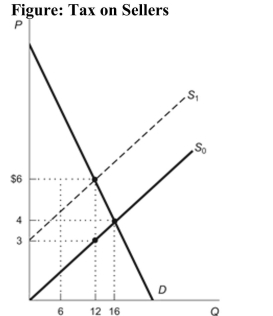 Reference: Ref 6-1 (Figure: Tax on Sellers) Refer to the figure. Suppose the imposition of a per-unit tax on sellers shifts the supply curve from S0 to S1. The equilibrium quantity sold under the tax is:
Reference: Ref 6-1 (Figure: Tax on Sellers) Refer to the figure. Suppose the imposition of a per-unit tax on sellers shifts the supply curve from S0 to S1. The equilibrium quantity sold under the tax is:
A) 4.
B) 12.
C) 16.
D) 10.
F) B) and C)
Correct Answer

verified
Correct Answer
verified
Multiple Choice
If a tax is imposed on sellers of a product the demand curve will:
A) shift upward.
B) shift downward.
C) not shift.
D) shift upward or downward depending on elasticity of demand.
F) None of the above
Correct Answer

verified
Correct Answer
verified
Multiple Choice
 Reference: Ref 6-4 (Figure: Tax on Supply and Demand) According to the figure, if the tax is placed on buyers, the equilibrium is at Point:
Reference: Ref 6-4 (Figure: Tax on Supply and Demand) According to the figure, if the tax is placed on buyers, the equilibrium is at Point:
A) B, and the equilibrium price and quantity are P3 and Q2.
B) C, and the equilibrium price and quantity are P3 and Q2.
C) C, and the equilibrium price and quantity are P1 and Q2.
D) D, and the equilibrium price and quantity are P2 and Q1.
F) B) and C)
Correct Answer

verified
Correct Answer
verified
Multiple Choice
Figure: Wage Subsidy 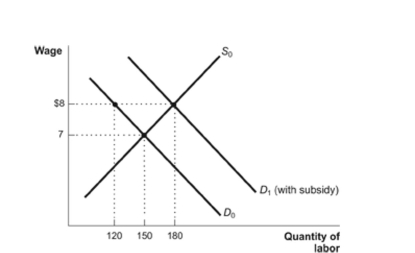 Reference: Ref 6-11 (Figure: Wage Subsidy) Refer to the figure. If a minimum wage of $8 had been implemented instead of a wage subsidy, how many workers would have been unemployed?
Reference: Ref 6-11 (Figure: Wage Subsidy) Refer to the figure. If a minimum wage of $8 had been implemented instead of a wage subsidy, how many workers would have been unemployed?
A) 60
B) 30
C) 180
D) 120
F) A) and D)
Correct Answer

verified
Correct Answer
verified
Multiple Choice
Which of the following statements is correct?
A) If the elasticity of demand is greater than the elasticity of supply, sellers will receive more of the subsidy.
B) If the elasticity of demand is greater than the elasticity of supply, sellers will receive less of the subsidy.
C) If the elasticity of demand is less than the elasticity of supply, sellers will receive more of the subsidy.
D) If the elasticity of demand is greater than the elasticity of supply, buyers will receive more of the subsidy.
F) A) and D)
Correct Answer

verified
Correct Answer
verified
Showing 41 - 60 of 100
Related Exams